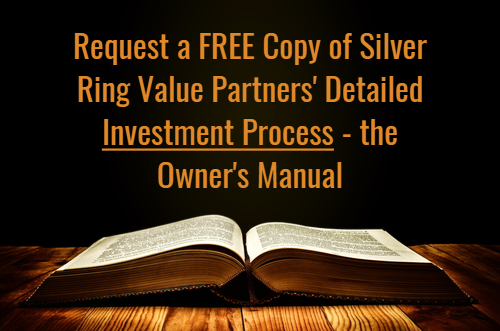What You Can Learn From My 50% Loss
/I was a young equity analyst at one of the largest mutual fund firms in the country. It was the week before Christmas in 2002, and my most important stock recommendation to the firm’s portfolio managers had just declined by 50%. In one day.
To the firm, the $100M+ investment was not important, but to a 22 year-old analyst who had negative net worth if you included student loans it was an astronomical sum. And it just got cut in half. Because of me.
December 18th, 2002 started out just fine, with my usual early morning commute into Boston. I checked in with my neighbor, Mike, to see what he was up to. Only then did I glance at my computer screen. I slumped in my chair, not believing the news: the company, PolyOne, had just announced that they were drastically lowering their financial guidance and suspending their dividend.
Six Months Earlier
Despite having just graduated from MIT the prior year, as a representative of one of the largest investors in the country I enjoyed unprecedented access to the management teams of the companies that I followed. My sole job, as explained to me by the Directors of Research, was to know my companies better than anyone in the world and to make investment recommendations to the firm’s portfolio managers so that they could make the best investments for the mutual funds that they managed.
I took full advantage of my ability to visit the companies, and spent plenty of time with PolyOne’s CEO, an impressive-sounding fellow who was a graduate of the Harvard Business School. I visited factories. I grilled the CFO on the financials. I read everything I could find. I spoke to competitors. In the end, I knew everything about this company, or so I thought.
The investment thesis was simple: this mini-conglomerate of plastics manufacturers was becoming a better business because of their ability to cross-sell their products to the same industrial customers. Or at least that’s what the CEO told me, as there was no real evidence of this “super-market” strategy working just yet. But it sounded so plausible at the time, and besides, could such a well-dressed and well-educated strategic visionary leader be wrong?
The math was pretty compelling as well: PolyOne was going to earn about $1 per share in earnings, and at a market-average Price-to-Earnings (P/E) multiple of 15x, the business should be worth $15. Perhaps more if the cross-selling business model really took off. At a price of $10 per share the stock was a bargain, trading at 2/3rds of my intrinsic value estimate.
Two Week Earlier
The job of an analyst at the firm involved making the rounds with the Portfolio Managers (PMs), the senior officers of the firm, and convincing them to invest in your recommendations. Analysts were graded by the PMs, so frequency was as important as depth, lest one allowed one of the many other analysts to snag a precious two-minute slot with an influential PM before the grades were due.
During my typical rounds one of the PMs who owned PolyOne stock was quite unhappy. The stock was not “acting” well. It was sliding from above $8 to the $6 range. The PM insisted that something was going on that we weren’t aware of.
Having recently discovered the writings of Benjamin Graham and Warren Buffett, but without any practical experience to speak of, I was very skeptical of such “technical” analysis. We were supposed to be fundamental investors, who cared what other market participants thought?
The PM insisted we call the management to check on how the business was doing. This would not have been my preference, since as a long-term investor I didn’t care about what the company was going to do in a quarter or two. However, I didn’t have much of a choice and I agreed to arrange the call.
I arranged the call with the CFO on the company’s end and a few of the PMs who led the call and me on our side. After some small-talk about baseball teams and the like, the PMs got down to business. Like experienced surgeons they deftly navigated the boundaries between the permissible and the disallowed by staying within the constraints of what they could ask the management team without violating SEC regulations on selective disclosure.
After the 30-minute call concluded, the grizzled veteran among the PMs said, in a matter-of-fact way: they are going to miss the quarter. The others nodded. I spoke up, attempting to remind them about the cross-selling strategy, the $1 per share of earnings, and the statistical cheapness of the stock that was now selling at approximately 6x that number. Finally, I appealed to them that fundamental investors we shouldn’t be concerned about a quarter. Besides, our position was too large to nimbly trade in and out of based on such minor developments. They weren’t happy with the situation, but they agreed.
December 18th, 2002
I didn’t have long to digest the news about the eliminated dividend and the dire financial outlook that the management team was now guiding to. Soon the stock market opened, and the short-term verdict was in: the stock was down 50%.
I felt physically sick. As you read these words you might intellectually relate to what I was going through, but I can assure you that unless you have experienced a similar situation you have no visceral idea how I felt. I literally wanted to crawl under my desk and cry.
Crying under my desk, however, was not an option. Analysts were expected to calmly analyze developments and immediately inform PMs who owned the stock about how they should proceed. The only thing worse than losing people money was hiding when the bad news came out.
I made my rounds, in a mental haze. I implored the PMs not to sell, arguing that yes, I missed the developments that got us here, but that at the new price of $3 the cat was out of the bag. In the back of my mind I wondered why anyone should even want to listen to me given that I got them into this mess to begin with. I remember one of the PMs, a Harvard man, in a well-meaning but condescending way telling me to take the rest of the day off, to go home, and to re-read what I had read by Buffett as clearly I hadn’t internalized the message. I finished my rounds and took his advice.
The Lessons:
Don’t believe management’s projections, but rather rely on evidence of actual accomplishments
Spend time understanding the quality of the business rather than getting lost in the financials. Some businesses are tougher than others and they are likely to remain so beyond the next quarter.
Don’t get overconfident because you know a lot of details about the business – it’s the few big things that matter
Spend time thinking about what can go wrong and what that will mean for the business before it happens, not just about how much money you might make if things go right
Don’t trust your own judgement, or the judgment of whoever is managing your money, until they have a few such experiences under their belt. You/they need to be tested to see if the requisite mental toughness to remain rational under extreme pressure is there and to cut down on the hubris for those who haven’t experienced serious losses
Conclusion
I should never have recommended PolyOne at $10. I had no idea what I was doing. I made many rookie mistakes of which I am not proud, and I learned from them. I am proud of how I handled the aftermath.
In the coming weeks I did thorough analysis on the company’s financials and concluded that:
The only way that the stock price of $3 made sense was if there was a serious chance of the company going out of business and
That my analysis of the business and the balance sheet made that very unlikely
I recommended we add to our position, and eventually, after a number of quarters that felt more like years to me at the time, the stock recovered. PolyOne was a big mistake, but one I am glad that I made early in my career, because it helped me improve as an investor and proved to me that I had the mental toughness and the temperament to making high-stakes investing decisions under pressure. You can do one better – learn from my mistake so that you can avoid making it yourself.
If you are interested in learning more about the investment process at Silver Ring Value Partners, you can request an Owner’s Manual here.
If you want to watch educational videos that can help you make better investing decisions using the principles of value investing and behavioral finance, check out my YouTube channel where I regularly post new content
Note: An earlier version of this article was published on Forbes.com




